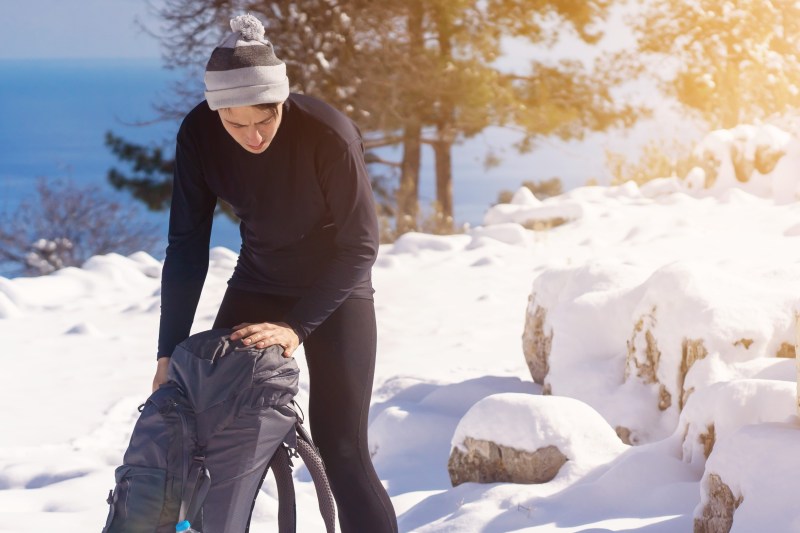In Nordic regions, they have an old proverb that says: There’s no bad weather, only bad clothing. As it turns out, there’s actually some truth to the saying! As someone who loves the winter, I’ve had my fair share of borderline-frostbitten toes, but ever since I discovered the merino wool base layer, I’ve been able to stay out longer than ever. Here’s everything you need to know about merino wool base layers and how to make the most of your gear.
For those unfamiliar with the layering system, a base layer is the innermost part of your gear. Think long underwear and socks. After that, you’ll wear an insulating mid-layer followed by a rain or wind-resistant outer shell. Believe it or not, the base layer is the most important layer because of moisture management. Fail to nail this step, and you’re probably going to be shivering out there on your bucket list adventure far sooner than you’d like.
What is merino wool, and why do I need it?

Since it’s against your skin, your base layer needs to be comfortable and fit well. You’re going to be miserable if this layer itches and chafes. Fortunately, merino wool isn’t your typical wool. Merino wool comes from merino sheep, usually out of New Zealand or Australia. Compared to regular wool, merino has very thin strands, resulting in a softer feel. But its real warming power comes with its moisture-wicking properties.
Moisture management is the key to staying warm, but if you’re out doing super strenuous winter activities like skiing, your base layer is bound to get sweaty. If you wear a cotton base layer, all of that moisture is going to stay right by your skin, causing you to chill as soon as you stop moving. Merino wool, however, pulls moisture away from your body, which will keep you warmer.
Merino wool is also warm because the fabric is full of air pockets. Air is great insulation when it’s trapped in fabric, but that’s not all. Merino wool will actually relax and release the trapped air when you get too hot, so there’s less of a chance you’ll sweat. The best part is that this process still happens when it’s wet, so even if you do break a sweat, it won’t compromise your layering system the way a cotton shirt will.
Another thing that you might notice if you wear a cotton base layer is an increased risk of B.O. Everybody gets it, especially during rigorous outdoor activities, but merino wool can actually help. There are actually scales on the fiber that make it tricky for bacteria to grow on it. No bacteria means no stink. Why buy more shirts than you need to? You can wash merino less often because it takes longer to smell, causing less wear on the shirt and using less water and electricity in the process.
How to take care of merino wool

Care for your merino wool base layers may be different depending on the brand and style, so check the manufacturer’s site to see if it has any care instructions online. If not, here are some expert tips for taking care of your merino wool gear:
- Spot clean: If your merino wool isn’t completely filthy, try spot cleaning. Gently dab small stains with a damp cloth.
- Use a gentle cycle or hand wash: Merino wool can handle a lot of use out in the wilderness, but when it comes to your washing machine, it’s best to use a gentle cycle or even hand wash it. This will increase the longevity of your items.
- Use mild detergents: Strong detergents may contain chemicals that will harm your merino wool, so use a mild detergent or soap, preferably one that is made for wool.
- Wash in cold water and air dry: Like most kinds of wool, merino wool can shrink or be damaged if washed in hot water. This also means that you shouldn’t put it in the dryer. Instead, lay your clothing on a flat surface to dry.
- Fold, don’t hang: Wool garments can stretch if hung, so be sure to fold them when you put them away. For this reason, you should also avoid wringing the fabric.
Alternative materials

Merino wool isn’t all rainbows and unicorns. It’s a premium product that doesn’t last as long as synthetic base layers. So, when you head out on your next trip, weigh the pros and cons of each type and choose your base layer. Note that 90% of the time, I pick merino.
However, if you’re going hard and merino irritates your skin, then there are a few other fabrics to consider.
Synthetic
First, the tried-and-true synthetic. A petroleum-based product, synthetic polyester blends are durable, cheap, and wick moisture very well. They can be stacked together with another layer to provide wicking as well as insulation all in one. The smell is the downside. And it doesn’t go away. Some synthetics come treated with an anti-bacterial coating that lasts a number of washes. Once it’s gone though, the stink creeps in.
Bamboo and silk
Bamboo and silk can be used as base layers as well. Both are anti-bacterial material and regulate your temperature well. The downside is they’re hard to find.
Cotton
Finally, everyone’s favorite fabric: cotton. Cotton is cheap, durable, and feels great against your skin. The problem is that it absorbs so much water — 27 times its own weight, in fact. That much water against your skin pulls the heat out of you, leaving you cold and wet. And that’s the last thing you want far away from civilization on a cold, wet trip.



